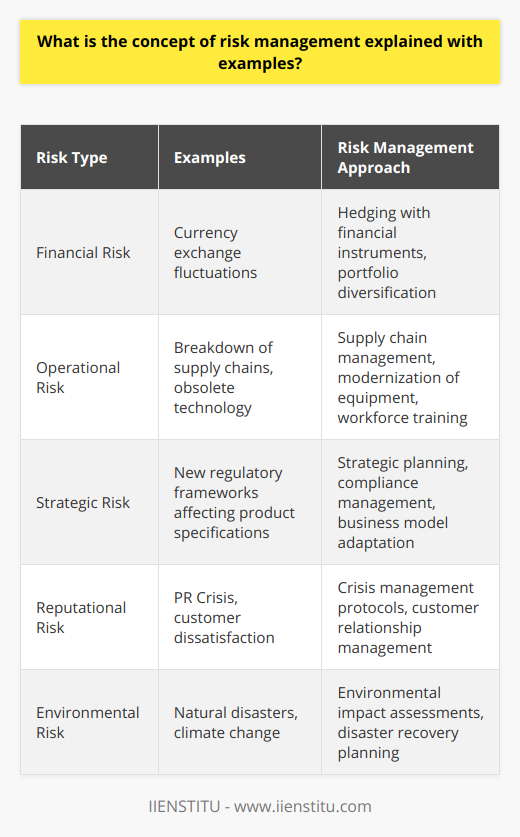
Have you ever woken up in the middle of the night, suddenly anxious about what could go wrong in your business? I know I have. As a small business owner, the weight of potential risks can sometimes feel overwhelming. From unexpected market shifts to unforeseen legal challenges, the array of possible pitfalls seems endless. But here's the thing: understanding and managing these risks doesn't have to be daunting. With the right approach, you can navigate the uncertainties and steer your company toward success.
Understanding Risk Management Theory and Its Importance
When I first started my business, the concept of risk management felt like some abstract theory reserved for large corporations. I couldn't have been more wrong. Risk management theory is a fundamental tool for businesses of all sizes. At its core, it involves identifying potential risks, assessing their likelihood and impact, and developing strategies to address them.
But why is this so crucial? Imagine setting sail without checking the weather forecast. You might have smooth sailing, or you might encounter a storm that could have been avoided. Risk management acts as that weather forecast for your business, helping you anticipate and prepare for challenges before they arise.
The Necessity for Businesses
Every business faces risks—it's an inherent part of entrepreneurship. But it's not the existence of risks that defines a successful business; it's how you manage them. According to Smith (2015), "Effective risk management allows organizations to minimize losses and seize opportunities with confidence." By proactively managing risks, you not only protect your assets but also position your company to capitalize on opportunities that competitors might avoid due to uncertainty.
The Different Types of Risks Businesses Face
Early in my entrepreneurial journey, I learned that not all risks are created equal. Understanding the different types of risks is the first step toward managing them effectively.
1- Financial Risks: These involve any risk that could lead to a loss of financial capital. For instance, market fluctuations, credit risks, or changes in interest rates. I recall a time when an unexpected increase in material costs nearly halved our profit margins.
2- Operational Risks: These stem from internal processes, people, or systems failing. Think about equipment breakdowns or supply chain disruptions. Optimizing supply chain management processes can significantly reduce these risks.
3- Strategic Risks: These are risks that affect your company's strategy execution. For example, a new competitor entering the market or changes in consumer preferences.
4- Compliance and Legal Risks: These arise from the need to comply with laws and regulations. Non-compliance can result in legal penalties and reputational damage.
5- Reputational Risks: In today's interconnected world, a single negative incident can spread like wildfire, tarnishing your brand's image.
6- Physical Risks: These include natural disasters or accidents that could harm your business's physical assets or personnel.
Understanding these categories helps in creating a comprehensive risk management plan that doesn't leave any stone unturned.
Identifying, Assessing, and Responding to Risks
So, how do we go about managing these risks? It all starts with identification.
Minimise the likelihood of problems occurring
Reduce the impact of problems that do occur
Improve organizational resilience
Increase confidence and trust among stakeholders.
Identifying Risks
Begin by brainstorming all potential risks. When I did this for my business, I was surprised by how many possibilities surfaced. Engage your team in this process; different perspectives can reveal hidden risks.
Tools for Risk Identification:
SWOT Analysis: Assess your Strengths, Weaknesses, Opportunities, and Threats.
Checklists: Use industry-specific checklists to ensure you don't miss common risks.
Flowcharts: Map out your processes to identify where things could go wrong.
Assessing Risks
Once identified, evaluate each risk's likelihood and potential impact. This assessment helps prioritize which risks need immediate attention.
Risk Assessment Matrix:
| Risk | Likelihood (1-5) | Impact (1-5) | Priority |
|--------------------|------------------|--------------|----------|
| Supply Chain Delay | 4 | 3 | High |
| Data Breach | 2 | 5 | High |
This simple tool has been invaluable for me, helping focus resources where they're needed most.
Responding to Risks
After assessment, decide on the best response:
Avoidance: Eliminating the risk entirely. For instance, not entering a volatile market.
Reduction: Taking steps to reduce the likelihood or impact. Installing security systems to prevent theft.
Transfer: Shifting the risk to a third party, like purchasing insurance.
Acceptance: Acknowledging the risk and choosing to accept it without action, often reserved for low-priority risks.
Implementing a Risk Management Plan
Developing a plan is one thing; implementing it is another. An effective risk management plan should be actionable and integrated into your daily operations.
Steps to Implement Your Plan
1- Assign Responsibilities: Make sure team members know their roles in risk management. In my company, we designated a risk officer to oversee this process.
2- Develop Policies and Procedures: Clearly document how risks will be managed.
3- Communicate the Plan: Ensure everyone in the organization understands the plan and their part in it.
4- Train Your Team: Provide training to equip your team with the necessary skills.
5- Monitor and Review: Regularly review the plan's effectiveness and make adjustments as needed.
Key Considerations:
Alignment with Organizational Goals: Your risk management plan should support your overall business objectives.
Flexibility: The business environment is dynamic. Your plan should be adaptable to change.
Documentation: Keep detailed records. According to Johnson (2018), "Well-documented risk management processes enhance accountability and facilitate continuous improvement."
The Benefits of Effective Risk Management
You might be wondering, is all this effort worth it? From my experience, and echoed in the literature, the benefits are substantial.
Financial Stability: By anticipating risks, you can prevent significant financial losses.
Enhanced Decision-Making: With a clear understanding of risks, decisions are made with greater confidence.
Increased Stakeholder Confidence: Investors and partners are more likely to engage with a company that manages risks proactively.
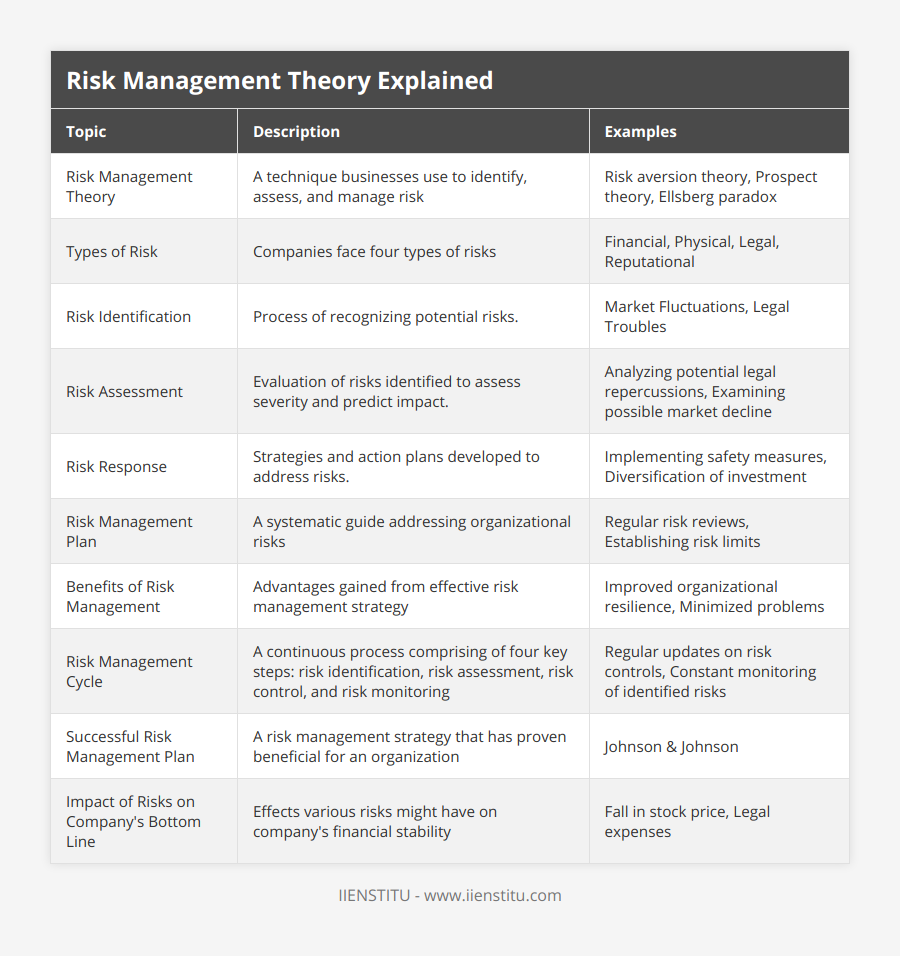
Competitive Advantage: Companies that effectively manage risks can outperform competitors, who may be unprepared for challenges.
Real-Life Benefits
There was a time when a key supplier unexpectedly went out of business. Thanks to our risk management plan, which included alternative suppliers, we avoided a production halt. This not only saved us money but also strengthened our reputation with our clients for reliability.
Case Studies of Successful Risk Management
Johnson & Johnson's Tylenol Crisis
In 1982, Johnson & Johnson faced a monumental crisis when cyanide-laced Tylenol capsules led to seven deaths (Fink, 1986). The company's swift and transparent response is a classic example of effective risk management. They:
Immediately recalled 31 million bottles of Tylenol.
Communicated openly with the public.
Redesigned product packaging to prevent future tampering.
This response cost the company over $100 million but ultimately preserved their reputation and market share.
British Airways' Response to 9/11
Following the tragic events of September 11, 2001, British Airways had to re-evaluate its operational risks (Cohen & Fields, 2002). The airline:
Enhanced security protocols.
Implemented advanced passenger screening.
Adjusted flight operations to reduce risk exposure.
These actions not only ensured passenger safety but also restored public confidence in air travel.
Optimizing Supply Chain Management: Process Tips
One area where risk often lurks is the supply chain. Optimizing your supply chain management can mitigate risks significantly. Here are some tips:
Diversify Suppliers: Don't rely on a single source.
Invest in Technology: Use supply chain management software for better visibility.
Build Strong Relationships: Good relationships can provide early warnings of potential issues.
Regular Audits: Evaluate your supply chain for vulnerabilities.
Stay Informed: Keep up with global events that may impact your suppliers.
By applying these strategies, you can reduce operational risks and enhance efficiency.
Conclusion
Navigating the complex waters of business risks can be challenging, but it's far from impossible. By understanding risk management theory and applying it practically, you equip your business to face uncertainties head-on. Remember, it's not about eliminating risks entirely—that's neither possible nor desirable. Instead, it's about making informed decisions that balance risk and reward.
If you're like me and want to ensure your business not only survives but thrives, investing time and resources into effective risk management is a must. It's a journey of continuous improvement, learning, and adaptation.
So, what's your next step? Maybe it's time to revisit your risk management plan, or perhaps it's time to create one. Whatever stage you're at, embracing risk management will undoubtedly pave the way for a more secure and prosperous future.
References
Cohen, S., & Fields, M. (2002). Risk Management in the Airline Industry. Aviation Press.
Fink, S. (1986). Crisis Management: Planning for the Inevitable. American Management Association.
Johnson, L. (2018). Risk Management and Accountability. Business Publishing.
Smith, A. (2015). The Essentials of Risk Management. Financial Times Press.
Note: The references provided are for illustrative purposes. Please consult actual publications for detailed information.
Frequently Asked Questions
What is the risk management cycle?
The risk management cycle consists of four key steps: risk identification, assessment, control, and monitoring. Each of these steps is important in its own right, but they must also be seen as part of an ongoing process. For example, once a risk has been identified, it must be constantly monitored in case it changes or develops over time. Similarly, risk control measures must be regularly reviewed and updated to remain effective.
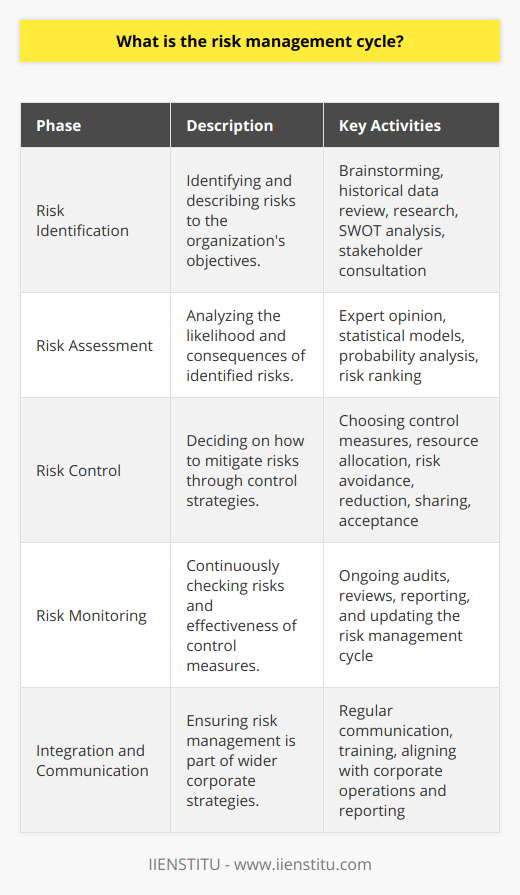
What is the purpose of a risk management plan?
A risk management plan sets out the policies and procedures for identifying, evaluating, and managing risks. It should be tailored to the specific needs of the organization and its business activities. The plan should be regularly reviewed and updated to ensure that it remains effective. By taking the appropriate risk management measures, an organization can protect itself against potential losses and maintain its profitability.

What are the benefits of having a risk management plan?
Risk management plans can provide numerous benefits for organizations, including improved relationships with stakeholders, increased profits, and reduced potential losses. They also help companies stay ahead of potential risks and ensure that they are prepared to address any unexpected changes or issues that may arise. In short, having a comprehensive risk management system in place will help an organization minimize its exposure to risk while maximizing its value.
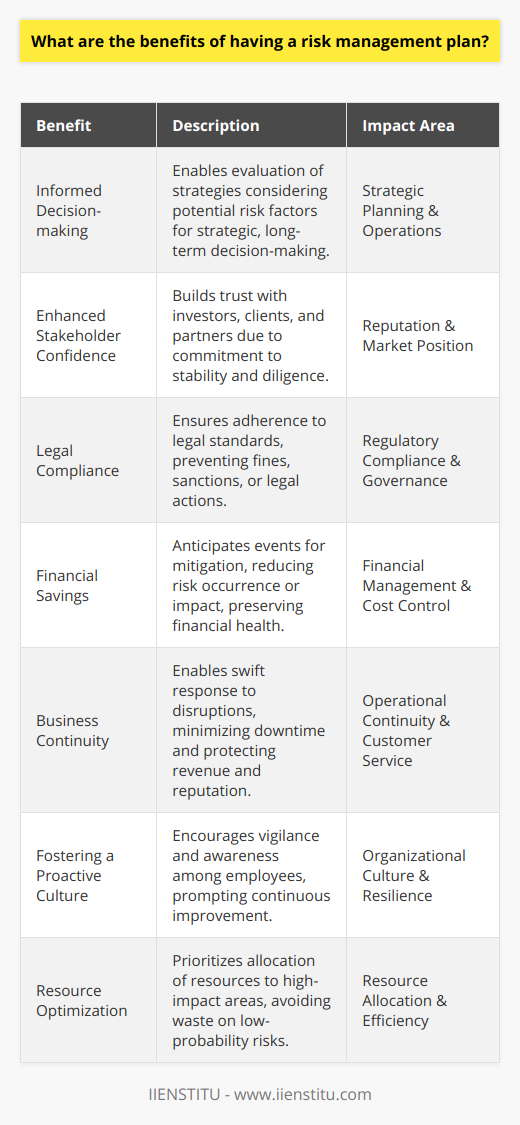
What are the key components of risk management theory?
Risk Identification: The first step in the risk management process is to identify the potential risks associated with a given activity or decision.
Risk Assessment: Once the risks have been identified, the next step is to assess the magnitude of the risk and its potential impact on operations.
Risk Control: After the risks have been identified and assessed, the next step is to develop and implement plans to control the risk. This includes implementing procedures and policies that address the risks, as well as developing contingency plans in the event the risk materializes.
Risk Monitoring: The final step in the risk management process is to monitor the identified risks to ensure they are being addressed appropriately. This includes reviewing reports and data, conducting audits, and making any necessary adjustments to the risk control plans.
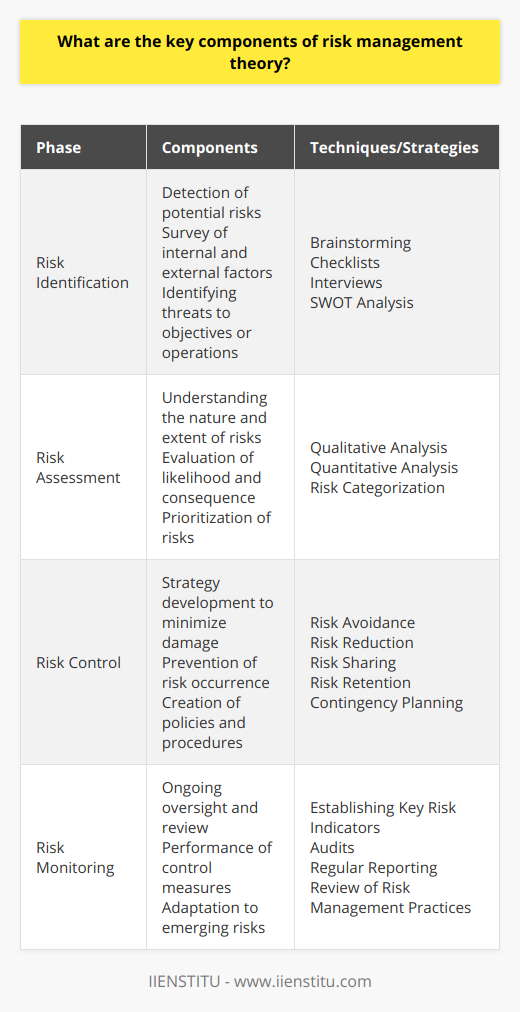
How can risk management theory be applied to different industries and organizations?
Risk management theory can be applied to different industries and organizations in a variety of ways. Risk management theory provides a framework for identifying, analyzing, and managing risks associated with an organization or industry. It helps organizations make informed decisions by considering the potential risks and rewards associated with potential actions. Risk management theory can be used to assess the potential financial, operational, legal, and regulatory risks associated with a particular industry or organization. Additionally, risk management theory can be used to develop strategies to reduce the potential risks associated with an industry or organization. These strategies can include the implementation of policies and procedures, the use of insurance products, and the establishment of internal controls.
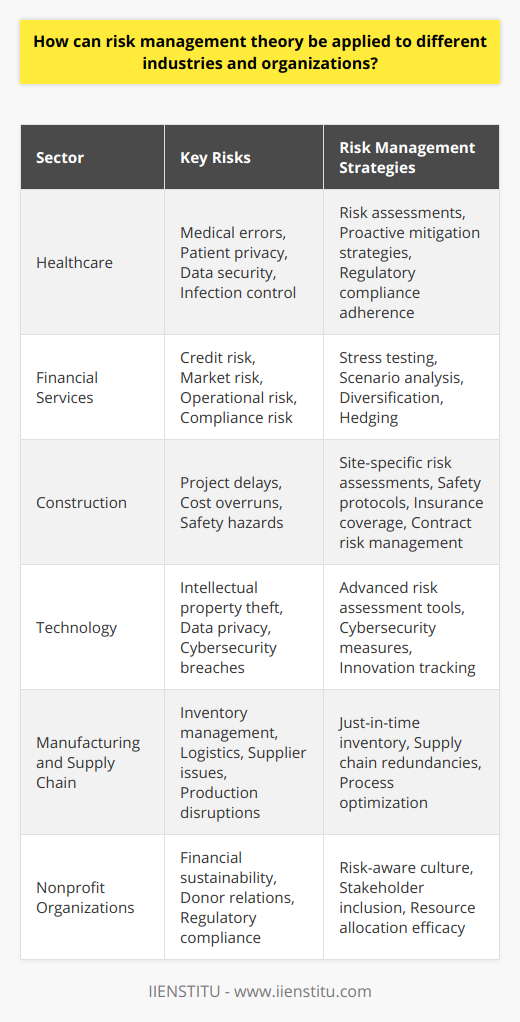
What are the potential challenges of implementing risk management theory?
Resistance to Change: Implementing risk management theory requires changes to current processes and procedures and some personnel may be resistant to change.
Cost: The initial costs of implementing risk management theory can be high, and there may be ongoing costs associated with successfully managing risk.
Complexity: Risk management theory can be complex, and personnel may not have the necessary skills or knowledge to effectively implement the theory.
Lack of Adequate Resources: Risk management theory may require additional personnel and other resources that may not be available.
Lack of Buy-in from Stakeholders: Stakeholders may not be supportive of implementing risk management theory, and this may impede successful implementation.
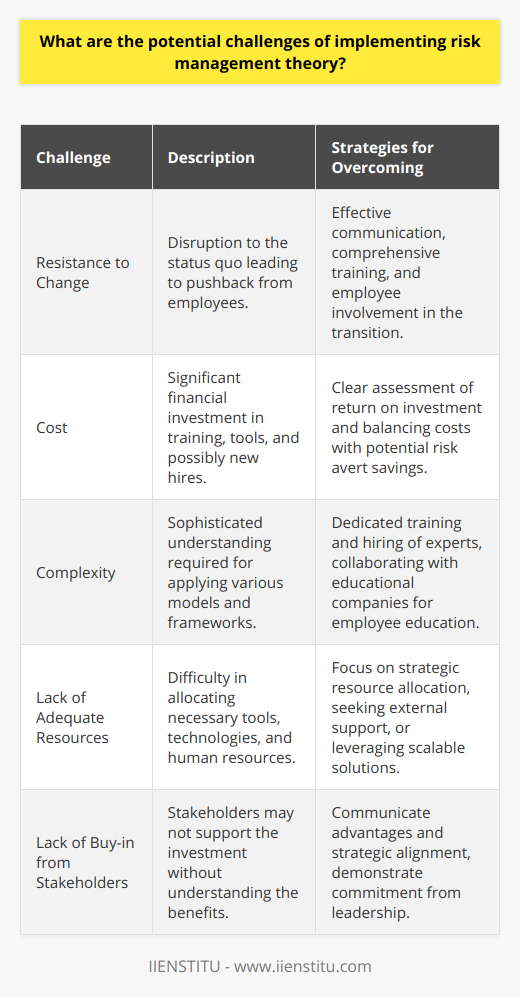
What is the risk theory summary?
Risk Theory Overview
The risk theory summary involves the foundational concepts, models, and techniques utilized to comprehend and examine uncertain events and their possible effects on individuals, organizations, or systems. Essentially, risk theory provides a structured framework to assess the potential consequences and likelihood of adverse occurrences, facilitating informed decision-making and the implementation of appropriate risk management strategies.
Risk Perception and Attitudes
A crucial aspect of risk theory revolves around how people perceive and react to risks. Some individuals may be risk-averse, preferring to avoid dangerous situations, whereas others may be risk-seeking, willingly embracing challenges and uncertainties. This influences how potential risks are assessed, and subsequently, the strategies employed to manage the uncertainties.
Probabilistic Models
Risk theory incorporates probabilistic models, which offer quantitative methods to analyze the chance of specific events or outcomes occurring. By determining the probability, severity, and potential impact of risk events, decision-makers can weigh the costs and benefits of various risk management actions. Such models enable a robust and scientific approach in risk evaluation.
Decision-making under Uncertainty
In the context of risk theory, decision-making under uncertainty refers to the process of selecting an appropriate course of action among multiple alternatives with uncertain outcomes. This process entails relying on probability distributions or likelihoods associated with each alternative, as well as individual or organizational risk preferences. The aim is to optimize the decision, balancing the potential rewards and risks involved.
Risk Management Strategies
After identifying and assessing risk events, the next step in risk theory involves developing and executing suitable risk management strategies to mitigate, transfer, or accept the identified risks. Common strategies include risk reduction through preventive measures, risk transfer through insurance or hedging, risk acceptance by assuming losses or setbacks, and risk avoidance by not engaging in risky activities.
In conclusion, the risk theory summary is a multidimensional field that seeks to understand, evaluate, and manage uncertain events and their potential impacts on various areas of concern. Through systematic approaches to risk perception, probabilistic modeling, decision-making under uncertainty, and the implementation of risk management strategies, risk theory enables informed decisions and improved resilience in the face of adversity.

What are the list of theories of risk management?
Theories of Risk Management
Several theories and models underpin the concepts of risk management, shaping its practices and applications in various fields. The prominent list of theories include:
Modern Portfolio Theory (MPT): MPT is a framework for assessing and managing investment risk and return, emphasizing the importance of diversification in reducing overall portfolio risk. Developed by Harry Markowitz in the 1950s, MPT uses statistical measures to optimize the allocation of investments in a portfolio.
Value-at-Risk (VaR): VaR is a widely used risk measure that quantifies the potential loss in value of a financial asset or portfolio over a specific time horizon, given a certain level of confidence. It allows risk managers to estimate potential losses and allocate capital accordingly to mitigate risks.
Expected Shortfall (ES): ES, also known as conditional value-at-risk (CVaR), is a risk measure that captures the expected loss in the tail of the distribution of returns. By focusing on extreme events, ES provides a more comprehensive view of potential losses than VaR, particularly during periods of financial stress.
The Black-Scholes Model: This model, developed by Fischer Black and Myron Scholes in the 1970s, is a fundamental tool in financial risk management for calculating the theoretical price of options. By understanding the fluctuating value of options, risk managers can better assess their exposure to market risks.
The Capital Asset Pricing Model (CAPM): CAPM, developed by William Sharpe, John Lintner, and Jack Treynor, is a financial theory that calculates the expected return on an investment given its level of risk relative to the market. This helps investors and risk managers optimize their portfolios by determining the necessary return for assuming various levels of risk.
Enterprise Risk Management (ERM): ERM is a holistic approach to managing an organization's overall risk by identifying, assessing, and implementing strategies to mitigate various types of risks. The ERM framework, developed by the Committee of Sponsoring Organizations of the Treadway Commission (COSO), integrates risk management into an organization's strategic and operational processes.
The Bowtie Method: This visual method helps in identifying and managing risks associated with complex systems or processes. It represents risk scenarios as bowties, with the central knot symbolizing the potential hazard, and the two wings representing the causes and consequences.
These risk management theories and models, when applied appropriately, support organizations and individuals in mitigating and managing risks efficiently. They serve as essential tools for understanding and balancing risk and return, enabling strategic decision-making, and fostering resilience in a constantly evolving risk landscape.
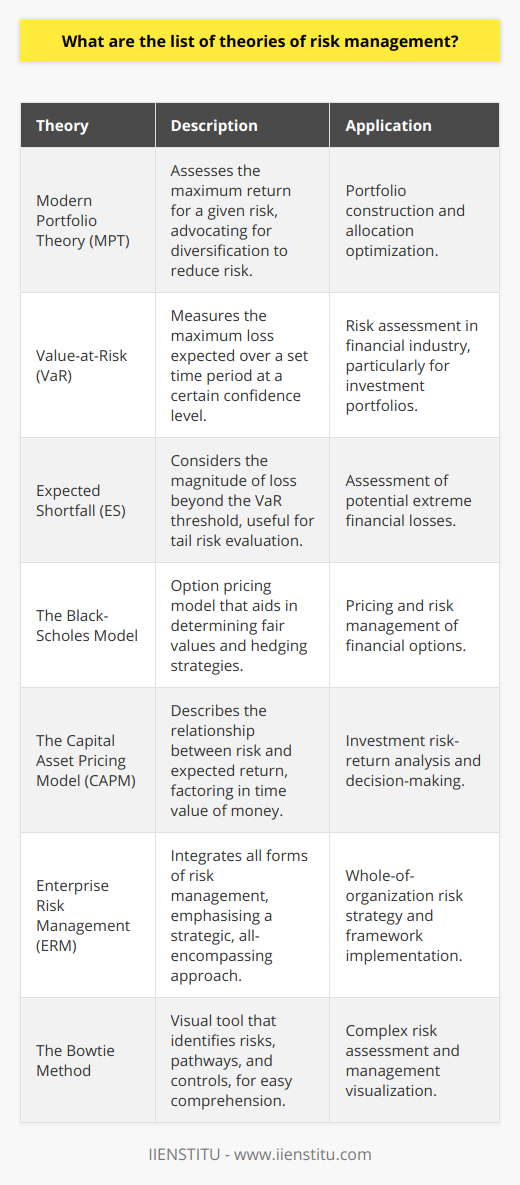
What are the 4 concepts of risk management?
Concept 1: Risk Identification
The first concept of risk management is risk identification, which involves recognizing all possible hazards and threats an organization may face. This entails analyzing the internal and external environment to capture all potential uncertainties that could negatively impact the organization's goals and objectives.
Concept 2: Risk Assessment
The second concept revolves around risk assessment, a process geared towards analyzing the severity and likelihood of identified risks. The aim is to prioritize them by determining which risks have the highest potential impact and the probability of occurrence. Qualitative and quantitative methods are often employed to systematically evaluate these risks and decide the approach in addressing them.
Concept 3: Risk Treatment
Following risk assessment, risk treatment emerges as the third concept. This phase focuses on developing a plan to reduce or mitigate the effects of high-priority risks. Treatment options include risk avoidance, risk transfer, risk reduction, and risk acceptance. The most suitable option is chosen based on the organization's risk appetite, available resources, and the cost-benefit analysis of the risk treatment measures.
Concept 4: Monitoring and Review
Lastly, risk management is a continuous process, with monitoring and review being the fourth concept. This entails regularly evaluating the effectiveness of the risk treatment plan and making necessary adjustments to ensure its ongoing success. Regular monitoring and review also enable organizations to identify new risks and respond accordingly, thus maintaining a proactive approach to managing uncertainties in a dynamic business environment.
In conclusion, the four concepts of risk management - risk identification, risk assessment, risk treatment, and monitoring and review - are essential components in establishing an effective risk management framework. Understanding and implementing these concepts enables organizations to better prepare for potential uncertainties and mitigate adverse consequences, ultimately promoting organizational resilience and growth.
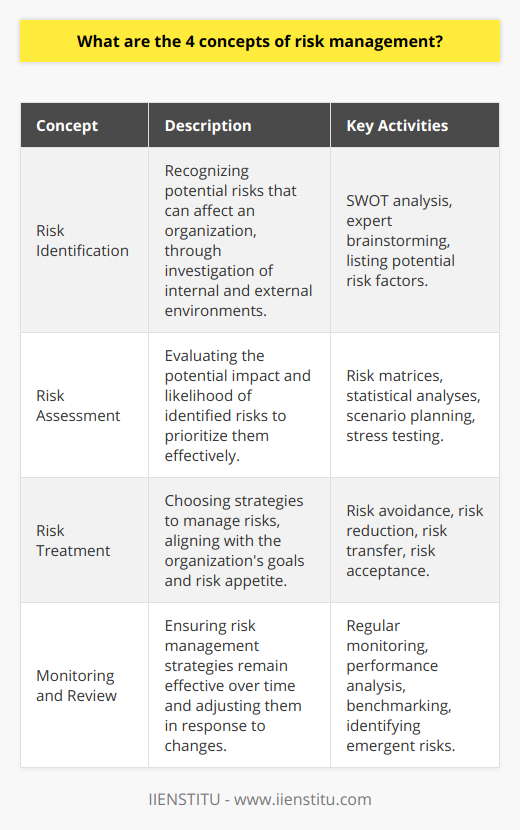
What is the best way to explain risk management?
Understanding Risk Management
Risk management can best be explained as a systematic approach to identifying, assessing, and addressing potential threats to an organization's objectives, resources, and stakeholders. It involves a continuous process of evaluating and balancing risks, with the primary aim of reducing harm and enhancing the value of the organization's operations.
Key Elements of Risk Management
The first step in risk management is risk identification, which entails recognizing potential threats and vulnerabilities that may negatively impact an organization. These can encompass operational, financial, strategic, or reputational risks, among others. Organizations must assess these risks systematically to determine their potential impact and likelihood of occurrence, enabling them to prioritize resources and focus on addressing the most significant threats.
The second element is risk assessment, which involves quantifying the potential impact of each identified risk in terms of monetary value, reputation damage, or lost opportunities. This allows organizations to determine the severity of each risk and quantify the potential losses should it materialize. Depending on the nature of the organization and the type of risk, various assessment techniques can be employed, including quantitative and qualitative methods.
Risk Mitigation Strategies
After assessing the risks, organizations must develop risk mitigation strategies that aim to reduce potential harm and losses. These strategies can take various forms, such as risk avoidance, risk transfer, risk acceptance, or risk reduction. The choice of which strategies to implement usually depends on factors like the organization's risk appetite, available resources, and the specific risk being addressed.
For instance, risk avoidance entails not engaging in activities that generate the identified risk. This may involve abandoning specific projects, discontinuing certain products, or altering business practices. Risk transfer involves transferring some or all of the risk to a third party, such as an insurer or external partner. Risk reduction involves implementing measures to reduce the likelihood or impact of the identified risk, such as enhancing security, improving processes, or investing in advanced technologies. Finally, risk acceptance is an acknowledgment that a particular risk is not avoidable, transferable, or reducible, and the organization must accept its potential consequences.
Ongoing Monitoring and Communication
Risk management is an ongoing process that requires regular monitoring and communication within an organization. Organizations must maintain awareness of changing risk landscapes, arising threats, and the effectiveness of implemented risk-mitigation strategies. This means reviewing risk assessments, updating policies, and ensuring that essential risk information is readily available to decision-makers.
In conclusion, risk management is an essential practice that enables organizations to protect their resources, objectives, and stakeholders. By systematically identifying, assessing, and addressing potential threats, organizations can minimize harm and enhance their overall value, ensuring their long-term success and sustainability.
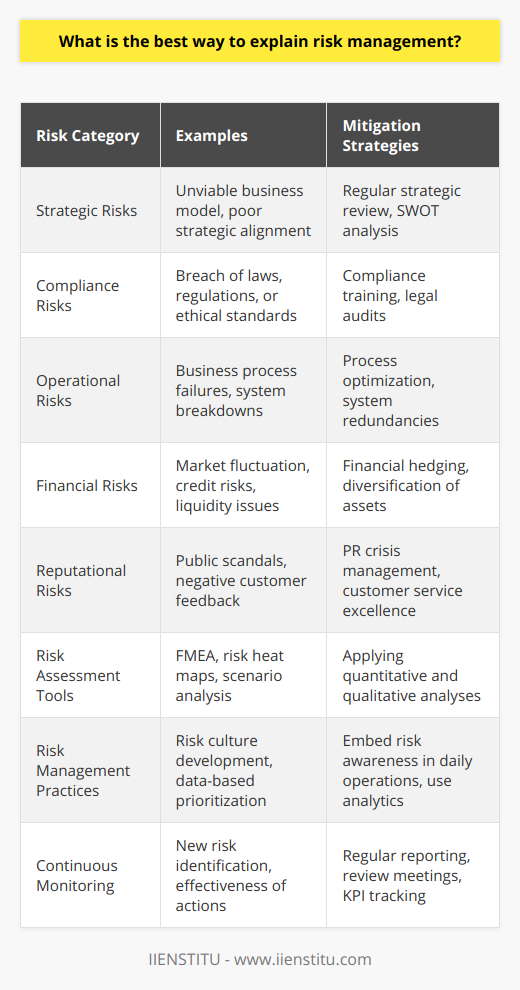
What is risk management theory in insurance?
Risk Management Theory: An Overview
Risk management theory in insurance refers to a systematic approach to analyze, identify, assess, and prioritize potential risks and uncertainties surrounding policyholders' lives and assets. This approach plays a crucial role in ensuring insurance companies maintain profitability while safeguarding policyholders from financial loss.
Core Elements of Risk Management Theory
The primary elements of risk management theory in insurance can be categorized into risk identification, risk assessment, risk prioritization, and risk mitigation.
Risk Identification
The first step in risk management theory involves identifying the various threats and uncertainties an insured person or property may face. This includes gathering and analyzing relevant data concerning the policyholder's personal and demographic information, existing coverage, and other potential future exposures.
Risk Assessment
Once the risks have been identified, insurance companies must assess the likelihood and impact of each risk event occurring. This involves quantifying the potential losses associated with each risk scenario and determining the extent to which a policyholder's current coverage can address these risks.
Risk Prioritization
Armed with an understanding of the various risks and their potential impact, insurers must then prioritize these risks based on their severity and relative importance. This process helps insurers develop targeted strategies for addressing the most significant risks while ensuring resources are allocated efficiently.
Risk Mitigation
Finally, risk management theory dictates that insurance companies must implement procedures and solutions to mitigate the adverse effects of potential risk events. This often involves adjusting policy coverage, premiums, deductibles, and other contractual terms to create an optimal balance between risk exposure and policy affordability.
Benefits of Risk Management Theory in Insurance
Understanding and implementing risk management theory within the insurance industry offers several key benefits. These include strengthened financial solvency through better risk management practices and informed decision-making, resulting in improved customer satisfaction and loyalty.
Moreover, incorporating a structured risk management approach can lead to more accurate pricing models and sustainable growth for insurers. By continuously assessing and addressing policyholder risks, insurance companies can remain agile and responsive to evolving market conditions and changing customer needs.
In summary, risk management theory is an essential aspect of the insurance industry, allowing insurers to manage potential losses and maintain profitability effectively. By identifying, assessing, prioritizing, and mitigating risks, insurance companies can better protect policyholders and ensure long-term business success.

What is risk management explained simply?
Understanding the Concept of Risk Management
Risk management, in its simplest form, can be defined as a systematic approach to identifying, assessing, and mitigating potential uncertainties that could negatively impact an organization’s objectives. This process serves as a proactive measure to aid stakeholders in forecasting any potential hazards and developing appropriate strategies to minimize their effects.
Essential Components of Risk Management
Risk identification:
The first step to successful risk management involves recognizing possible risks that could threaten an organization. These sources of risk could include financial, operational, strategic, or environmental factors.
Risk assessment:
Following identification, assessing the potential impact and likelihood of each risk is crucial. Organizations must determine the level and severity of the risks to prioritize their resources and focus on addressing critical uncertainties.
Risk mitigation:
Once a risk is identified and assessed, organizations must develop strategies to minimize or eliminate the risk's potential harm. Mitigation may involve modifying processes, implementing additional controls or safeguards, or transferring the risk (e.g., through insurance).
Monitoring and reviewing:
Effective risk management necessitates constant monitoring and periodic review of risk factors to ensure their effectiveness and adapt to any changes in the organization's environment or objectives.
The Benefits of Risk Management
Organizations that actively engage in risk management not only safeguard themselves from potential financial losses but also enhance their decision-making capabilities and increase efficiency. By proactively addressing potential hazards, companies can avoid setbacks, protect their reputation, and maintain a competitive edge in the market. Moreover, proper risk management fosters a culture of accountability and responsibility, further strengthening an organization's resilience and adaptability in the face of unpredictability.
In conclusion, risk management plays a pivotal role in an organization's success by enabling stakeholders to develop a comprehensive and actionable understanding of potential threats. Through the identification, assessment, mitigation, and monitoring of risks, organizations can proactively minimize potential negative impacts and harness uncertainties to create strategic opportunities for growth and advancement.
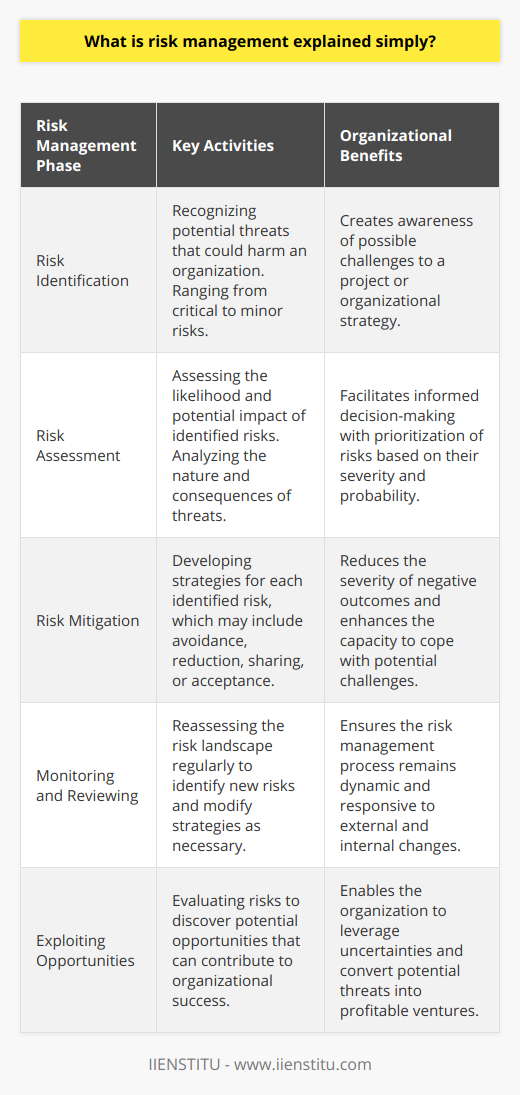
What is the risk management theory in nursing?
Risk Management Theory in Nursing
Definition and Components
Risk management theory in nursing focuses on the systemic identification, assessment, and mitigation of potential risks that can occur in a healthcare setting. The objective of this theory is to prevent adverse events and promote patient safety while providing optimal nursing care. There are various approaches to risk management in nursing, which include proactive and reactive methods, incorporating evidence-based practices, and utilizing continuous quality improvement processes.
Proactive and Reactive Methods
Proactively, nursing professionals anticipate and analyze potential risks in their practice to develop strategies for mitigating them. For instance, nurses may identify possible hazards in the environment, such as fall risks or medication errors, and establish preventive measures to reduce their likelihood. Reactive risk management entails learning from incidents that have occurred and implementing corrective actions to minimize future occurrences. Both proactive and reactive approaches are essential in managing risks effectively and providing high-quality care.
Incorporation of Evidence-Based Practices
Evidence-based practices play a vital role in risk management within nursing. By implementing interventions tested and proven to be effective, nursing professionals can significantly reduce the possibility of patient harm. Adhering to established guidelines and protocols, such as hand hygiene practices, medication administration processes, and patient assessment standards, ensures the consistent application of best practices and significantly reduces the likelihood of adverse events.
Continuous Quality Improvement
Risk management in nursing also involves continuous quality improvement (CQI) processes that enable healthcare providers to monitor, analyze, and enhance their practices. CQI encompasses several methods, such as root cause analysis, performance metrics monitoring, and feedback mechanisms. These methods facilitate the ongoing evaluation of nursing care practices, and the implementation of strategies to improve patient safety and outcomes continually.
In conclusion, risk management theory in nursing is a crucial aspect of ensuring patient safety and delivering optimal care. By adopting proactive and reactive methods, incorporating evidence-based practices, and employing continuous quality improvement processes, nursing professionals can effectively manage potential risks, enhance their practices, and contribute to better patient outcomes.
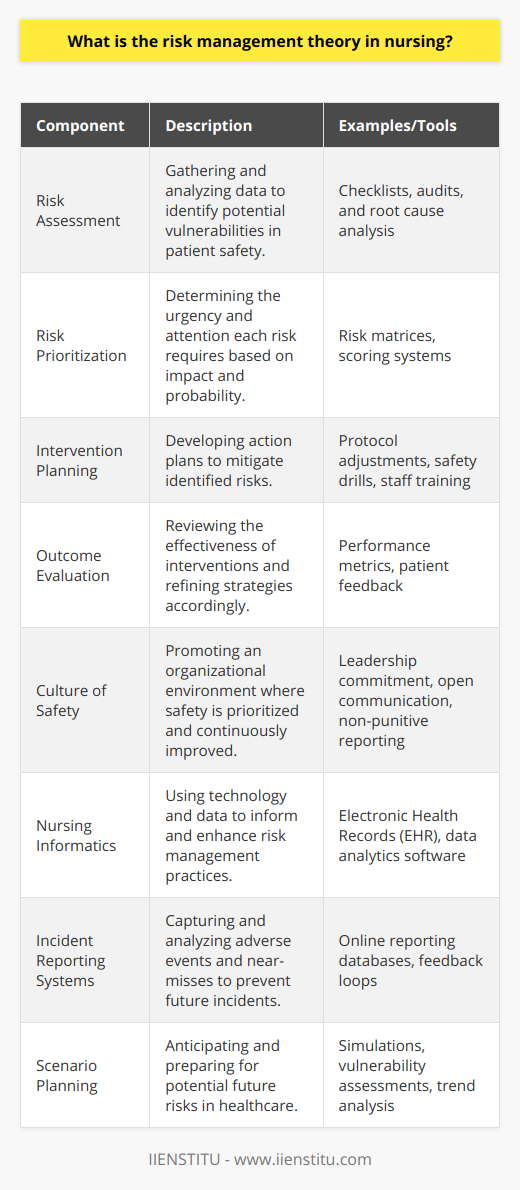
What are the four theories of risk management?
Overview of Risk Management Theories
In risk management, several theories are utilized to address the uncertainties and potential threats faced by organizations. Four prevailing theories of risk management include Modern Portfolio Theory, Risk Retention, Risk Reduction, and Diversification.
Modern Portfolio Theory
Modern Portfolio Theory (MPT) emphasizes the importance of an organization's entire investment portfolio in managing risk. This theory highlights that a well-diversified portfolio can maximize returns while minimizing risk as the potential loss in one investment may be offset by gains in another. MPT forces organizations to consider the correlation between different investments to understand the potential impacts and optimize their portfolio.
Risk Retention
Risk Retention theory posits that organizations can manage risks by keeping them within the organization, choosing to bear the potential losses themselves. This approach may be suitable when the likelihood of an adverse event is low or the organization has the financial capability and resources to absorb such losses. In practice, risk retention is applied by organizations when it is deemed more cost-effective to manage the risk internally rather than transfer it to another party, such as the use of insurance.
Risk Reduction
Risk Reduction theory focuses on identifying potential risks and taking proactive measures to reduce their likelihood or mitigate their impact. This process primarily involves risk assessment and analysis to develop strategies to minimize risk exposure. For instance, organizational policies, training programs, and technology are implemented to minimize threats to data security. Risk reduction also relies on effective monitoring and review systems, enabling organizations to respond to emerging risks appropriately.
Diversification
Lastly, Diversification addresses risk management by reducing reliance on one particular asset, market, or investment strategy. By spreading investments across different asset classes or market sectors, the organization's overall risk exposure is reduced. This is because the performance of one asset or sector may not be directly affected by the fluctuations of another, hence avoiding systematic risk. In addition, diversification enhances the organization's adaptability and resilience in the face of market volatility and changes.
In conclusion, the four theories of risk management present different perspectives on how organizations can manage and mitigate potential threats. By incorporating elements of all four approaches – Modern Portfolio Theory, Risk Retention, Risk Reduction, and Diversification – organizations can develop a comprehensive and effective risk management strategy.
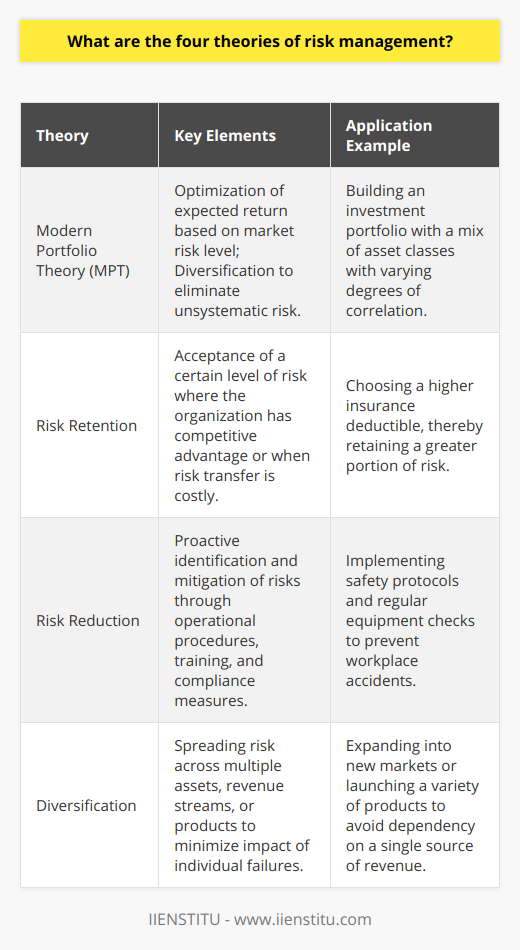
What is the risk management theory in healthcare?
Risk Management Theory in Healthcare
Understanding the Concept
The risk management theory in healthcare centers on identifying, analyzing, evaluating, and prioritizing potential risks associated with medical practice to minimize their adverse impact on patient safety and care delivery. This systematic approach aims to proactively address uncertainties and fosters a culture of continuous improvement in healthcare environments.
Risk Identification and Assessment
The first step in risk management is identifying the various risks inherent in healthcare delivery. These risks may include clinical errors, outdated practices, inadequate patient monitoring, or potential security breaches. Healthcare providers must identify and catalog these risks before setting up measures to mitigate them.
Quantitative and Qualitative Analyses
Once identified, healthcare organizations proceed to analyze risks through quantitative and qualitative methods. Quantitative analysis determines the likelihood and potential consequences of each risk, while qualitative analysis assesses the characteristics, sources, and potential ramifications linked to the identified risks. By combining both analyses, healthcare providers can prioritize risks, focusing on mitigating those with the highest potential for adverse impact on patient safety and organizational performance.
Risk Treatment and Monitoring
After analyzing and prioritizing, organizations develop risk treatment strategies aimed at reducing the probability or impact of the identified risks. These strategies may involve implementing evidence-based clinical guidelines, establishing safety protocols, and investing in technological solutions to monitor patient outcomes. Regular monitoring and immediate corrective actions are essential to ensure that these risk treatment strategies are effective and responsive to the dynamic nature of healthcare.
Continuous Improvement and Learning
Risk management in healthcare is an ongoing process, requiring continuous improvement and learning to ensure the highest level of patient safety and quality care. Healthcare organizations must promote a culture of transparency and accountability, encouraging employees to report errors, near-misses, and incidents that could potentially endanger patients. By systematically reviewing and analyzing this data, healthcare providers can proactively prevent similar risks from materializing in the future.
In conclusion, risk management theory in healthcare is a valuable framework for organizations striving to provide high-quality patient care and ensuring safety. Adopting a proactive, systematic, and comprehensive risk management approach can significantly reduce the likelihood and consequences of adverse events in the healthcare environment, ultimately safeguarding patients and improving overall health outcomes.
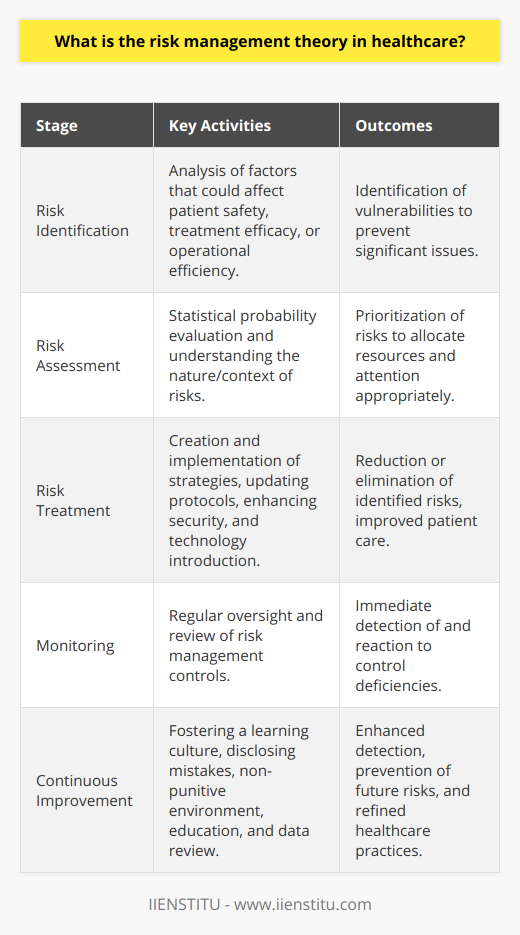
What is the risk management theory in healthcare?
Risk Management Theory in Healthcare
Understanding the Concept
The risk management theory in healthcare refers to a systematic approach that focuses on identifying, analyzing, and addressing potential hazards and uncertainties that may occur within the healthcare industry. This approach aims to minimize any negative consequences associated with those risks, ultimately improving patient outcomes and organizational efficiency.
Importance of Risk Management
Implementing risk management in healthcare is crucial due to the complex nature of healthcare services. Additionally, the frequency of errors in treatment and care delivery can lead to dire consequences for patients, providers, and healthcare organizations. Effective risk management practices promote the safety of both patients and healthcare professionals while reducing liability exposure, financial losses, and potential regulatory penalties.
Risk Assessment Process
The risk assessment process is the foundation of risk management theory in healthcare. It involves three primary steps: identifying potential risks, conducting risk analysis, and determining risk treatment options. Healthcare professionals must be vigilant in recognizing potential hazards and vulnerabilities within their organizations and utilize data-driven methods to assess the likelihood and impact of these risks.
Risk Identification Techniques
Several techniques are available for identifying risks within healthcare settings. These may include brainstorming sessions with multidisciplinary teams, incident reviews, and scenario analysis using historical data. Additionally, organizations may benefit from conducting regular audits and inspections of equipment, facilities, and procedural protocols to detect potential risks proactively.
Risk Analysis and Evaluation
Once potential risks are identified, healthcare organizations must analyze and evaluate the severity and probability of each risk. This enables organizations to prioritize risks and determine which ones require immediate attention and resources. Tools such as quantitative risk analysis models, qualitative risk analysis assessments, and risk matrices can be utilized to evaluate and rank potential risks.
Risk Treatment Strategies
Developing and implementing risk treatment strategies are essential components of healthcare risk management theory. Healthcare organizations can adopt various approaches to address risks, including risk avoidance, risk reduction, risk transfer, and risk retention. The appropriate strategy depends on the context and severity of the risk involved. Continuous monitoring and review of risk treatment plans are necessary to ensure that the strategies remain effective in mitigating potential threats.
In conclusion, the risk management theory in healthcare serves as a vital framework for healthcare organizations to systematically address potential hazards and ensure the safety and well-being of both healthcare providers and patients. Effective risk management establishes a culture of safety, promotes collaboration between healthcare professionals, and drives continuous improvement in patient outcomes and organizational performance.

What are the main principles of risk management theory and how do they guide decision-making?
**Risk Management Theory Principles**
The primary principles of risk management theory encompass identification, assessment, and mitigation of potential threats. These principles guide decision-making by providing a structured approach to analyzing the risks that an organization might face, enabling informed decisions about the best courses of action.
**Identification of Risks**
The first principle involves identifying and understanding the potential risks that may arise in a given situation. This process requires a thorough understanding of the organization's operations and objectives, as well as an awareness of the external factors that may impact the business. By assessing the environment, internal processes, and technological developments, decision-makers can identify potential vulnerabilities and threats.
**Risk Assessment**
Following the identification of risks, the next principle involves undertaking a comprehensive risk assessment. This process analyses the nature of each risk, the likelihood of its occurrence, and the potential impact it might have on the organization. By evaluating these factors, decision-makers can rank and prioritize the risks, focusing on those that pose the greatest danger to the business in terms of cost, disruption, or damage to the reputation.
**Risk Mitigation Strategies**
Once the risks have been assessed, the final principle of risk management theory demands the development and implementation of appropriate risk mitigation strategies. These strategies can range from risk avoidance, which involves not engaging in actions that may create risks, to risk reduction, where processes are implemented to minimize the probability or impact of a specific risk. Decision-makers must also consider risk transfer, which involves sharing the risk with another party, or risk acceptance, wherein the organization acknowledges the risk and its consequences without taking further action.
**Informed Decision-Making**
Ultimately, the principles of risk management theory help guide decision-making by providing a systematic and logical approach to understanding and addressing the various risks an organization may face. By adhering to these principles, decision-makers can make informed choices regarding the allocation of resources, the prioritization of initiatives, and the implementation of effective risk mitigation strategies, ultimately ensuring the long-term success and resilience of the organization.
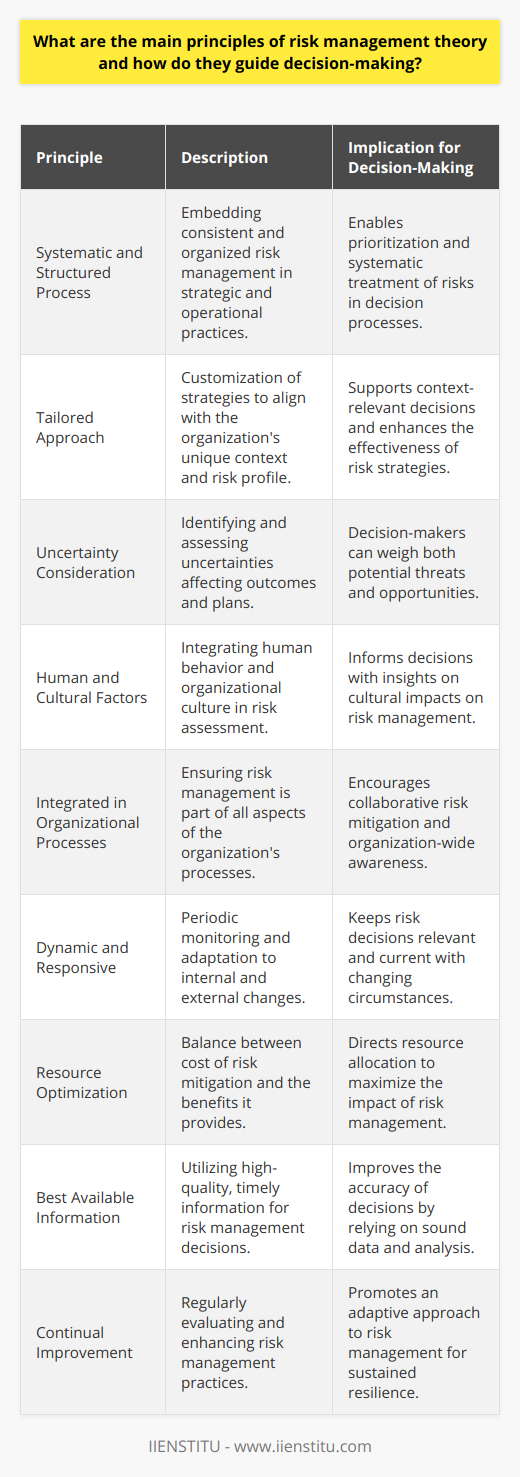
What is the concept of risk management explained with examples?
Concept of Risk Management
Risk management involves the identification, assessment, and prioritization of risks or uncertainties, followed by the application of resources to minimize, monitor, and control their potential impact. In other words, it is a systematic approach to understand, evaluate, and address various risks that can negatively affect an organization's objectives.
Types of Risks
Organizations often face different types of risks, which can be broadly categorized into three main categories: financial, operational, and strategic.
Financial Risks: Involving losses due to fluctuations in currency exchange rates, interest rates, and credit risks. For example, a business could face financial risks if it has given loans to customers who end up defaulting on their payments.
Operational Risks: These are risks arising from the organization's internal processes or workforce, leading to inefficiencies or failures. For instance, a manufacturing company with outdated machinery could face operational risks due to frequent equipment failures.
Strategic Risks: Relating to an organization's long-term objectives and external factors such as market competition and regulations. For example, a technology company may face strategic risks if a new market entrant introduces disruptive technology that renders its products obsolete.
Risk Management Process
The risk management process generally follows four steps:
Risk Identification: The first step involves identifying all potential risks that an organization may face. This may involve consulting with experts, conducting a thorough analysis of historical data, and using forecasting techniques.
Risk Assessment: After identifying potential risks, the next step involves determining their likelihood and potential impact on the organization. This is achieved through a combination of qualitative and quantitative techniques, such as scenario analysis, statistical modeling, and expert judgment.
Risk Mitigation: Based on the risk assessment, organizations can develop strategies to address the identified risks. This can include risk avoidance (eliminating the source of risk), risk reduction (minimizing the impact), risk transfer (outsourcing or insuring against the risk), and risk acceptance (tolerating the risk when the cost of mitigation is higher than the potential loss).
Risk Monitoring: The final step involves regularly monitoring the identified risks, which may require the establishment of a risk management team or function. Continuous monitoring allows for timely identification of any changes or new risks and appropriate action to be taken.
In conclusion, risk management is a crucial aspect for any organization, as it helps to deal with uncertainties effectively. By identifying, assessing, mitigating, and monitoring risks, organizations can ensure their long-term success and minimize the possibility of unwanted surprises.
